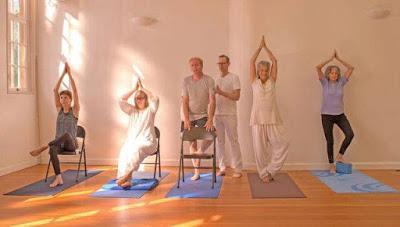
Accessible Yoga by Sarit Z Rogers of Sarit Photography
A short while back, we were privileged to have a guest post The Imperfect Yoga Teacher by Jivana Heyman of Accessible Yoga. It was a moving and honest account of being what he called the “imperfect yoga teacher,” which resonated with many of our readers, me included. In that post, he also mentioned his organization Accessible Yoga, which he described as having the intention of "changing the consciousness around who can practice yoga and who can consider themselves a yogi."I actually first heard the term “Accessible Yoga” quite a few years ago when Jivana contacted me about the possibility of participating as a faculty member in his unique “Accessible Yoga” teacher training (conducted then in San Francisco), which trains adults with physical disabilities to become yoga teachers specializing in working with those with disabilities and physical challenges, as well as seniors. In fact, at the time, I was already several years into assisting a weekly class at was known as the Cerebral Palsy Center of Oakland, (now Ability Now Bay Area) for adult men with cerebral palsy. So I witnessed up close how the yoga practice could be adapted to meet the needs and desires of adults with significant disabilities in a very successful way. And the concept of adapting yoga practice to meet the needs of your students was one that had been a part of my own teacher training, which was led by four amazing teachers from the Iyengar tradition, as well as my studies with Iyengar teacher Donald Moyer in Berkeley for many years. It was also re-enforced by my experiences in India in 2005 at the Krishnamacharya Yoga Mandiram, where developing appropriate individualized yoga practices is the cornerstone of working with all adults. And Jivana’s vision of Accessible Yoga also meshes wonderfully with our way of thinking at Yoga for Healthy Aging, which recognizes that one-size yoga practices do not fit all and that your yoga practices need to change as you age and/or as your health status changes.So I jumped at the chance to be a part of Jivana’s new training, and in 2011 and 2012 I taught some of the anatomy portion of these trainings. It was inspiring to meet and work with a small but earnest group of students, all of whom were working with their own unique health and aging issues as they trained to work with others in need. And although after 2012 I was no longer participating in his trainings, I continued to follow the progress of Accessible Yoga with great interest. And I’m pleased to say that I've seen some of those early graduates have gone on to offer classes in accessible yoga in the San Francisco Bay area to the benefit of our communities here.Jivana eventually moved from the San Francisco area to Santa Barbara, became owner of Santa Barbara Yoga, and continued to grow his Accessible Yoga program, which is now international in its reach. And the organization he founded now offers trainings and conferences focusing on the Accessible Yoga style of yoga, which is trauma informed and makes yoga available to all, regardless of physical ability. I think it is worth reading their mission statement: “Accessible Yoga is dedicated to sharing the benefits of Yoga with anyone who currently does not have access to these practices, and with communities that have been excluded or underserved. All people, regardless of ability or background, deserve equal access to the ancient teachings of Yoga, which offer individual empowerment and spiritual awakening. By building a strong network and advocating for a diverse Yoga culture that is inclusive and welcoming, we are sharing Yoga with all.”I feel that the continued growth of Accessible Yoga is so important as many of us are working to change the stereotype that yoga is just for well-off, young, and perfectly healthy practitioners and have a mission to bring the many benefits of yoga to much broader audience, which includes people of all ages, races, body types, and levels of abilities and those with physical limitations, illnesses, and age-related health issues. So I believe Yoga for Healthy Aging walks hand-in-hand with organizations like Accessible Yoga, which have a vision of a world in which everyone, regardless of physical ability or age has access to the tools of yoga to improve their health and well-being. If you want to experience first-hand one of their trainings or conferences or want to be come an Accessible Yoga ambassador, check out the Accessible Yoga website to learn more. And their next conference is just around the corner in San Francisco, CA, October 6-8, 2017! I will have the honor of teaching a few sessions there on Yoga for Healthy Aging and Accessible Yoga. You can still save 10% off the registration fee by uses the code “Baxter” when you register at accessible-yoga-conference. Subscribe to Yoga for Healthy Aging by Email ° Follow Yoga for Healthy Aging on Facebook ° Follow Baxter Bell Yoga on Instagram ° Join this site with Google Friend Connect
